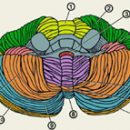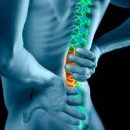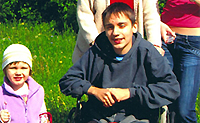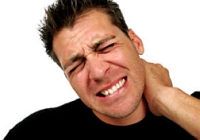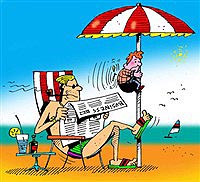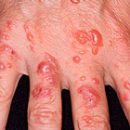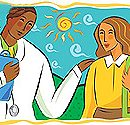It is believed that in 80% of cases, Guillana Barre syndrome can be fully cured. This is true, but this can be done only on time recognizing the disease. What you need to know about this disease to start the treatment in a timely manner? The necessary information is in this article.
Content
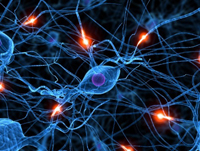 Hyien-Barre syndrome (infectious polyneurite, Landry-Guien-Barre syndrome, or acute idiopathic polyneurite) is a rather rare and unusual nervous disease with the name, which is not all remember. Why did I decide to talk about him suddenly, and not about something more, alas, the usual - stroke or radiculitis? They are not more than 4,000 people annually, but they are not easier. Uniquely because it is one of the very few nervous diseases that are successfully amenable to therapy and can be cured completely with appropriate diagnosis and alertness.
Hyien-Barre syndrome (infectious polyneurite, Landry-Guien-Barre syndrome, or acute idiopathic polyneurite) is a rather rare and unusual nervous disease with the name, which is not all remember. Why did I decide to talk about him suddenly, and not about something more, alas, the usual - stroke or radiculitis? They are not more than 4,000 people annually, but they are not easier. Uniquely because it is one of the very few nervous diseases that are successfully amenable to therapy and can be cured completely with appropriate diagnosis and alertness. So imagine that you are not, not you, let it be some other, an abstract person without a face - that he got sick. He picked up the usual cold, or his intestine was upset. He cured himself with the familiar means, which is full of in any pharmacy, and in a few days everything went. He is again healthy and cheerful. He goes to the cinema, to work, walks with girls and eats ice cream. However, the week passes, or two, or even four, and it appears strange sensations: tingling in brushes and feet. After some time, these troubles disappear, but new, more disturbing appear: the patient appears weakness in feet and brushes, and sometimes in the muscles of the face. And this weakness in the limbs rapidly dates back to the hips and above, if it starts in the legs, or descends down, if it appears first in the brushes. As a result, she can hit the respiratory muscles, and in this case a person risks to die, and quickly. The weakness of the respiratory muscles is developing unpredictably quickly and requires immediate medical actions, but approximately 4 people out of 100 ills die.
Typical features of the disease: symmetrical weakness of the muscles - the main neurological sign, first it usually arises in the legs (ascending type) and then the races are stamped into hands and facial muscles for 24-72 hours. Sometimes the weakness of the muscles is developing first in the hands (downward type) or simultaneously in the hands and legs. With lighter forms of this disease, weakness develops only in facial muscles or does not occur at all. Another frequent neurological sign is paresthesia (goosebumps and tingling), which usually precedes muscle weakness, but quickly passes. However, in some patients with this disorder, this symptom does not develop. Other manifestations can be facial dipling (sometimes with ophthalmoplegia - paralysis of facial and ocean muscle muscles), dysphagia (swallowing violation) or dysarthria (vague speech). Muscular weakness develops so quickly that muscle atrophy does not occur, but they have their lethargy and lack of reflexes. It is often noted by refractory and pain in the form of a cruel spasm in the legs. Since Guillana Barre syndrome causes inflammation and degenerative changes both in the rear (sensitive) and in the front (motor) roots, signs of sensitivity and movements occur simultaneously. Peripheral nerves are affected.
To serious complications of Hyien-Barre syndrome include lack of mechanical ventilation of the lungs, aspiration («sucking»), pneumonia, sepsis, contractures (limiting mobility) of joints and thrombosis of deep veins. Inexplicable involvement in the process of the vegetative nervous system may be accompanied by sinus tachycardia or bradycardia, arterial hypertension, postural hypotension (pressure drop with a change of posture) or loss of control over the sphincters of the bladder and intestines. Most people have a week or months there is a complete recovery of movements and sensitivity. With the rapid development of the patient's disease, it is necessary to check for the loss of sensitivity on the ascending type for the loss of sensitivity on the rising type, making it by means of touches or light pinchs. At the same time moving from the iliac ridge to the blade, periodically applying injections by the blunt end of the pin to check the patient's ability to distinguish sharp and stupid. During this procedure, the level of loss of sensitivity is noted to track changes. If the level rises slightly above the navel, then the patient is most likely broken by the intercostal muscles and respiratory function. When Guillayen Barre syndrome begins to retreat, the level of impairment of sensitivity and weakness of the muscles is descended to the most lower breast segment, marking the restoration of the functions of intercostal muscles and limbs. When diagnosing hyeien-barre syndrome, there is a history of preceding disease with elevated temperature (usually respiratory infections) and typical disease manifestations. Diagnosis It is necessary to eliminate similar diseases, for example, acute poliomyelitis.
The initial phase corresponds to the appearance of the first distinct symptom and ends after 1-3 weeks, when further deterioration does not happen.
The next phase - the plateau phase (lack of changes) lasts from several days to 2 weeks.
Behind it, a phase of recovery is followed, which, according to the coincidences with re-hyelinization (the formation of a new myelin around the nerves) and the restoration of nerve processes. The phase of recovery is stretched by 4-6 months; In patients with a disease in heavy form, it can take up to 2 years, and recovery may be incomplete. The best prognosis when symptoms disappear 15-20 days after the start of the disease.

